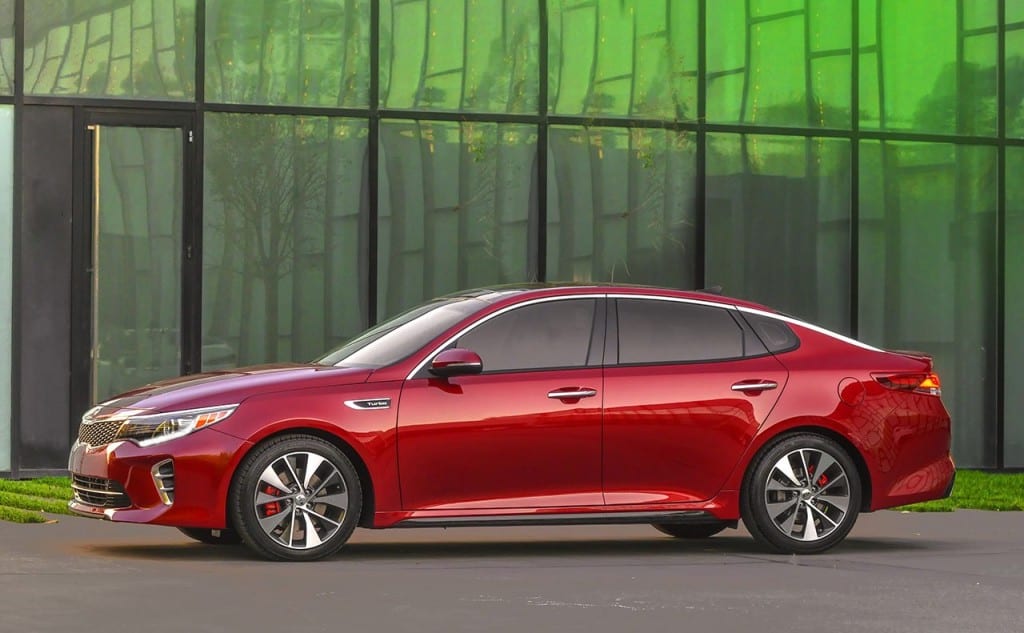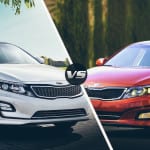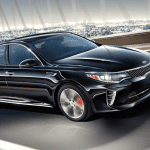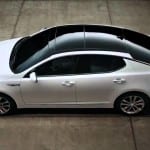The 2016 Kia Optima now has another accolade to add to its long list of accomplishments.
After establishing itself as the brand’s best-selling model, the nameplate was recently awarded the highest possible safety designation from the Insurance Institute for Highway Safety. By being named a Top Safety Pick plus (TSP+), the vehicle has proven itself in each of the organization’s “five crashworthiness tests.” To earn the TSP+ designation, a vehicle needs to earn at least a “good” rating in each of the five tests, a task that’s easier said than done.
The Kia Optima knocked it out of the park when it was tested, earning “good” ratings in small overlap front, moderate overlap front, side impact, roof strength and head restraints testing, as well as a “superior” rating in the front crash prevention. It’s difficult for vehicles to secure even one of these ratings, putting the Optima on a pretty exclusive pedestal.
“The Insurance Institute for Highway Safety sets some of the highest standards of crashworthiness, and the Top Safety Pick Plus designation is a significant achievement for the Kia brand and for our best-selling vehicle,” said Orth Hedrick, the vice president of product planning at KMA. “We are pleased that the all-new Optima received strong ratings across the range of rigorous tests set forth by IIHS. This rating validates the efforts of our engineers and the priority we place on safety for our consumers.”
While the IIHS generally focuses on broader safety testing, we decided to zero in on several specific reasons why the Optima has established itself as not only one of the safest mid-size cars, but one of the safest vehicles in general. Plus, we’ve even noted how the brand has started to preach safe driving habits to young drivers, emphasized by their relationship with a non-profit organization.
If you’ve been seeking a safe and reliable car for your growing family, you may be inclined to visit Miami Kia dealers once you’ve finished reading our guide…
A Protective Design
Similar to most vehicles, the Kia Optima’s safety abilities starts with the car’s design. More than half of the car is composed of Advanced High Strength Steel, an amount the company boasts is a 150% increase over previous models. The inclusion of this metal vicariously makes the chassis stiffer, and it also makes the body a bit more durable. To further improve the vehicle’s handling, engineers placed the suspension points outward, which boosts “suspension geometry for a smoother ride over uneven pavement.” Meanwhile, the dual bushing mounts increase the lateral stiffness, which subsequently improves the steering response and tractability.
Meanwhile, the ring-shaped section that helps define the opening behind the rear seats plays an important role in improving the vehicle’s rigidity (a 58-percent increase over previous models). Meanwhile, the 16 core stress areas will help boost “the driving dynamics” while also presenting a quieter ride. Even the panoramic sunroof was designed for safety, as the carbon-fiber-reinforced plastic helps shave off some weight and present a better center of gravity.
Other clever exterior additions include meticulously-designed engine mounts, body panels, and wheels. These three inclusions will help reduce the Optima’s vibration, engine noise, and road noise.
While you may not necessarily think that these factors influence your safety, they actually play a significant role in keeping your vehicle on the road. A driver is obviously more likely to crash their vehicle if they don’t have complete control. These various improvements to the mechanics ensure that whoever is operating the Optima is receiving optimal handling and drivability.
Variety of Safety Technologies
The Kia Optima also includes several innovative technological safety features that will help prevent collisions, thus keeping you and your passengers safe.
These driving aids include the Advanced Smart Cruise Control, which will help maintain a consistent speed without compromising safety. When the Optima is suddenly approaching another vehicle at too great of a speed, the Kia will manipulate its brakes to prevent a collision. The Front Collision Warning System provides similar accommodations when you’re controlling the vehicle. If you become distracted and approach another vehicle too quickly, the vehicle will alert you and subsequently apply the brakes to prevent an accident (with assistance from the Autonomous Emergency Braking system).
Meanwhile, the Blind Spot Detection (with Lane Change Assist) will alert you when another car has suddenly appeared beside you, and the audible and visual warnings will prevent you from accidently switching lanes. The Rear Cross Traffic Alert and Lane Departure Warning System serves a similar role, alerting you when it’s safe to switch lanes or back-up from your parking spot.
Worried that you might dent your Optima when attempting to park in a narrow spot? The Rear Parking Assist System will easily guide you into the space, as the sensors will detect when you’re too close to a vehicle.
Each of these safety technologies will influence how you operate the vehicle, helping the driver avoid danger via audible and visual signals. Without this assistance, you may have found yourself in a very serious accident.
How Kia is Teaching Safe Driving Habits to Teenage Drivers
To further emphasize their commitment to safety, Kia recently expanded their partnership with B.R.A.K.E.S. (Be Responsible and Keep Everyone Safe). The non-profit organization will be holding “free, hands-on defensive driving workshops” in March and April, with workshops taking place in Orlando, San Francisco, Seattle, and Southern California. The program is aimed at teen drivers, with the hope that they’ll engage in safe driving habits.
As the brand’s press release explained, car crashes are the “leading cause of death among 15-17-year-olds,” and the first half-year on the road tends to be the most dangerous. B.R.A.K.E.S. won’t solely be focused on young drivers, as they’re also hoping to influence their parents, too. The release notes that teens with parents who have “set driving rules and monitor their activities” are half as likely to be in an accident. Furthermore, these drivers are 71-percent less likely to drive under the influence, and they’re 30-percent less likely to use a cell phone while driving. Unfortunately, only 25-percent of parents have talked with their children about the dangers of driving, making it especially important that they accompany their children to these workshops.
“Kia is committed to continuing to support B.R.A.K.E.S.’ efforts to reduce teen traffic fatalities through hands-on defensive driving instruction,” said Tim Chaney, Vice President of Marketing Communications, KMA. “The B.R.A.K.E.S. program provides teens and their parents with high-quality individual training to help them make better decisions behind the wheel.”
These types of moves help confirm Kia’s dedication to safety, especially among their younger drivers. While some car companies are more intent on sales, Kia has proven that they’re actually focused on the well-being of their customers.
Kia’s safety accolades shouldn’t be too much of a surprise. The brand has shown a strong commitment to producing some of the safest vehicles on the market and this sentiment has been confirmed in their products. The Optima features a number of technological safety features, and the vehicle’s design also plays an important role in keeping the occupants protected. The nameplate and the brand certainly don’t appear to be slowing down, especially when it comes to these safety amenities. We should only expect similar amenities throughout the Kia line in the coming years.







